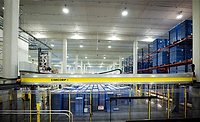Automation
Modularity brings flexibility in automating production lines
It also affords processors the ability to experiment with changes in batches or creating entirely new products, often with simply re-configuring lines.

June’s 2020 Food Engineering Plant Construction Survey revealed that the vast majority of processors are increasing production to meet demand. But demand today is a little different than it was in years gone by. Back then, consumers were happy with long-running brands, and there was relatively little variability in product choices. Today, consumers expect to choose from a wide choice of brands and products—not just from the “center” of the store, but fresh and organic products from the periphery of the store. Sometimes new products are short lived and are designed to be that way—because consumers’ choices turn on a dime. Automation can help processors turn products around faster by increasing production.
But increasing production is only part of the story. The larger part of the story is being able to adapt to produce new products in changing formats and packaging sizes. This demands a lot of flexibility, and one way to achieve this flexibility is through modularization. Modularization increases flexibility, but a process and its facility needs to be designed to be flexible through creating modular pieces of automation that can be easily moved in and out of a process.
I spoke with Mark Howard, country manager at EU Automation, about modularization as he sees it from the perspective of who’s buying automation equipment and parts for what applications. EU Automation stocks and sells new, used, refurbished and obsolete industrial automation spares. Its global network of preferred partner warehouses, and wholly owned distribution centers, enables it to offer a unique service within the automation industry, spanning the entire globe.
FE: What are the benefits of taking the modularization route?
Howard: As a production method, modularization allows a manufacturer to assemble hardware in its plant by combining individual modules into a desired order. As the name suggests, the production line is split into modules, removing the traditional rigid format of production lines and enabling manufacturers to modify their format however they like.
FE: How do you turn this concept into reality—something that works on the plant floor?
Howard: Typically, a factory’s production line is made up of individual production cells, with each cell given a specific function in the process—distributing, testing, processing, handling, assembly and storage. Modular production allows a factory to break down these cells into separately functioning modules, creating the opportunity to reformat these modules more flexibility. Acting like building blocks, a completely new production line can be created.
FE: How might this work in a real-world situation?
Howard: Take the production of baked goods as an example. By splitting the factory’s operating hours into different batches of production, a food manufacturer can produce several different types of product, without making drastic changes to the facility. For example, connecting a production cell designed to dispense a chocolate coating could allow a factory to produce both chocolate coated and plain versions of the same biscuit. Simply removing the dispensing module from the line means the rest of the production line doesn’t need reprogramming, nor does the factory need manually adjusting between each production batch.
While the biscuit example is a very simplified case study, it demonstrates how modularization can allow manufacturers to change the application of hardware to add flexibility to production.
FE: What other benefits of modularizing lines could be realized?
Howard: The rearrangement of modules also offers the opportunity to test and experiment with the food manufacturing process. It gives manufactures the opportunity to see which hardware works better where, by temporarily repositioning modules rather than exhausting the capacity of the entire production line.
Modules can be used to create a smaller version of the production line, allowing manufacturers to build a mental picture of what production could look like going on mass. For instance, should a food manufacturer want to begin production of a brand-new product, it is beneficial to run a test batch of this first. This also helps demonstrate how to scale up for larger production, whilst accurately determining a time to market estimation.
FE: Wouldn’t a processor be able to get a better picture of how a line might perform by breaking it up into constituent pieces?
Howard: Yes. This testing process also provides an opportunity to learn from the data generated. For instance, calculating how many operators would be required for production and identify opportunities to improve the effectiveness of manufacturing and calculate process capability index (CpK) values.
A modular approach can allow food processors to add, remove or change hardware from a production line, with almost no interruption. In the food manufacturing industry, processes must be reliable, repeatable and error free, with the ability to adapt and quickly ramp up production when necessary.
FE: What does EU Automation bring to the table?
Howard: The market, and its ever-changing demands, is moving faster than ever, and food manufacturers must move with it. That’s why, having access to industrial parts through suppliers, such as EU Automation, can support food manufacturers with their efforts for modular production equipment.
EU Automation is based in major countries around the world including the UK and U.S. In the U.S., readers can reach EU Automaton at 877-830-2021, 871 Busse Road, Elk Grove Village, Chicago, IL 60007. Contact Jonathan Wilkins at jonathan.wilkins@euautomation.com. The U.S. website is located at www.euautomation.com/us.
Looking for a reprint of this article?
From high-res PDFs to custom plaques, order your copy today!









